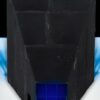An interdisciplinary team of researchers at the University of Antwerp (Belgium) successfully conducted in-situ studies with a plasma generated inside a scanning electron microscope (SEM). This marks the first time live SEM imaging while treating the sample with a plasma was achieved. The study is published in the journal Advanced Materials Technologies.
Plasmas, often described as ionized gases or the fourth state of matter, have a wide range of applications. For example, in the semiconductor industry, they fulfill a critical role in the lithographical process used to make computer chips.
They are also gaining significant interest for green chemistry applications, such as CO2 and CH4 conversion into value-added chemicals or renewable fuels, N2 fixation for green fertilizer production, as well as for biomedical applications, such as cancer treatment, wound healing, or disinfection. Further, plasmas are also a subject of extensive research to gain more fundamental insights.
Many of the relevant processes for plasma applications happen at a microscopic level and their observation often requires high-resolution images beyond a conventional light microscope’s capabilities. Therefore, a scanning electron microscope (SEM) was used in this research.
Such a microscope uses a focused beam of highly energetic electrons, which is scanned across the surface of the material of interest. By collecting various signals produced by the electron beam and compiling them pixel by pixel, highly magnified images of the sample can be generated, down to the nanometer regime.
To conduct these in-situ plasma studies in an SEM, several challenges needed to be addressed. Firstly, electron microscopes are typically operated under high-vacuum conditions to minimize electron interactions with gas molecules.
To create the required gas cloud for a plasma, a thin tube with a micrometer-sized hole at the end was introduced to the microscope chamber to allow a controlled gas flow toward the sample. The limited gas flow was sufficient for local plasma operation while maintaining a low pressure in the rest of the microscope for imaging.
Secondly, creating and sustaining a plasma requires a strong electric field which can affect the electrons needed for the microscopic imaging. By optimizing the setup’s hardware and parameters, the team minimized the deflection of the electron beam and ensured a stable plasma discharge, enabling live imaging during plasma operation. This way, a real-time view of the treatment of a copper film could be captured, as shown in the video above/below.
This significant achievement was only possible thanks to the interdisciplinary team of researchers who could work on this project. People with a background in electronics, electron microscopy, and plasma technology, supervised by Prof. Jo Verbeeck (EMAT research group) and Prof. Annemie Bogaerts (PLASMANT research group), joined forces to reach this major milestone.
As a next step, the team now aims to further develop the analytical capabilities of the instrument by incorporating additional detectors beyond imaging for real-time elemental and structural characterization, which could lead to new insights into materials science research and the fundamentals of plasma physics.
More information:
Lukas Grünewald et al, In Situ Plasma Studies Using a Direct Current Microplasma in a Scanning Electron Microscope, Advanced Materials Technologies (2024). DOI: 10.1002/admt.202301632
Provided by
University of Antwerp
Citation:
Researchers achieve real-time microscopic imaging during plasma treatment (2024, February 28)



